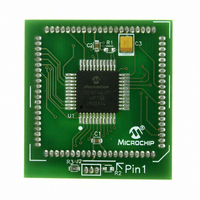MA180023 Microchip Technology, MA180023 Datasheet - Page 201

MA180023
Manufacturer Part Number
MA180023
Description
MODULE PLUG-IN PIC18F46J11 PIM
Manufacturer
Microchip Technology
Series
PIC®r
Datasheet
1.MA180023.pdf
(528 pages)
Specifications of MA180023
Accessory Type
Plug-In Module (PIM) - PIC18F46J11
Tool / Board Applications
General Purpose MCU, MPU, DSP, DSC
Mcu Supported Families
PIC18
Supported Devices
Stand-alone Or W/ HPC(DM183022) Or PIC18(DM183032)
Silicon Manufacturer
Microchip
Core Architecture
PIC
Core Sub-architecture
PIC18
Silicon Core Number
PIC18F
Silicon Family Name
PIC18FxxJxx
Lead Free Status / RoHS Status
Lead free / RoHS Compliant
For Use With/related Products
HPC Explorer Board (DM183022) or PIC18 Explorer Board (DM183032)
For Use With
DM183032 - BOARD EXPLORER PICDEM PIC18DM183022 - BOARD DEMO PIC18FXX22 64/80TQFP
Lead Free Status / RoHS Status
Lead free / RoHS Compliant
Available stocks
Company
Part Number
Manufacturer
Quantity
Price
Company:
Part Number:
MA180023
Manufacturer:
Microchip Technology
Quantity:
135
- Current page: 201 of 528
- Download datasheet (8Mb)
12.5.1
The Timer1 oscillator is also available as a clock source
in power-managed modes. By setting the clock select
bits, SCS<1:0> (OSCCON<1:0>), to ‘01’, the device
switches to SEC_RUN mode; both the CPU and
peripherals are clocked from the Timer1 oscillator. If the
IDLEN bit (OSCCON<7>) is cleared and a SLEEP
instruction is executed, the device enters SEC_IDLE
mode. Additional details are available in Section 3.0
“Low-Power Modes”.
Whenever the Timer1 oscillator is providing the clock
source, the Timer1 system clock status flag, T1RUN
(TCLKCON<4>), is set. This can be used to determine
the controller’s current clocking mode. It can also
indicate the clock source currently being used by the
Fail-Safe Clock Monitor. If the Clock Monitor is enabled
and the Timer1 oscillator fails while providing the clock,
polling the T1RUN bit will indicate whether the clock is
being provided by the Timer1 oscillator or another
source.
12.5.2
The Timer1 oscillator circuit draws very little power
during operation. Due to the low-power nature of the
oscillator, it may also be sensitive to rapidly changing
signals in close proximity. This is especially true when
the oscillator is configured for extremely low power
mode (LPT1OSC = 0).
The oscillator circuit, displayed in Figure 12-2, should
be located as close as possible to the microcontroller.
There should be no circuits passing within the oscillator
circuit boundaries other than V
If a high-speed circuit must be located near the
oscillator (such as the ECCP1 pin in Output Compare
or PWM mode, or the primary oscillator using the
OSC2 pin), a grounded guard ring around the oscillator
circuit, as displayed in Figure 12-3, may be helpful
when used on a single-sided PCB or in addition to a
ground plane.
© 2009 Microchip Technology Inc.
USING TIMER1 AS A
CLOCK SOURCE
TIMER1 OSCILLATOR LAYOUT
CONSIDERATIONS
SS
or V
DD
.
PIC18F46J11 FAMILY
FIGURE 12-3:
In the low drive level mode, LPT1OSC = 0, it is critical
that RC2 I/O pin signals be kept away from the oscillator
circuit. Configuring RC2 as a digital output, and toggling
it, can potentially disturb the oscillator circuit, even with
relatively good PCB layout. If possible, it is recom-
mended to either leave RC2 unused, or use it as an input
pin with a slew rate limited signal source. If RC2 must be
used as a digital output, it may be necessary to use the
higher drive level oscillator mode (LPT1OSC = 1) with
many PCB layouts. Even in the higher drive level mode,
careful layout procedures should still be followed when
designing the oscillator circuit.
In addition to dV/dt induced noise considerations, it is
also important to ensure that the circuit board is clean.
Even a very small amount of conductive soldering flux
residue can cause PCB leakage currents, which can
overwhelm the oscillator circuit.
12.6
The TMR1 register pair (TMR1H:TMR1L) increments
from 0000h to FFFFh and rolls over to 0000h. The
Timer1 interrupt, if enabled, is generated on overflow
which is latched in interrupt flag bit, TMR1IF
(PIR1<0>). This interrupt can be enabled or disabled
by setting or clearing the Timer1 Interrupt Enable bit,
TMR1IE (PIE1<0>).
Note: Not drawn to scale.
Timer1 Interrupt
OSCILLATOR CIRCUIT
WITH GROUNDED
GUARD RING
V
OSC1
RC0
V
OSC2
RC1
RC2
DD
SS
DS39932C-page 201
Related parts for MA180023
Image
Part Number
Description
Manufacturer
Datasheet
Request
R

Part Number:
Description:
Manufacturer:
Microchip Technology Inc.
Datasheet:

Part Number:
Description:
Manufacturer:
Microchip Technology Inc.
Datasheet:

Part Number:
Description:
Manufacturer:
Microchip Technology Inc.
Datasheet:

Part Number:
Description:
Manufacturer:
Microchip Technology Inc.
Datasheet:

Part Number:
Description:
Manufacturer:
Microchip Technology Inc.
Datasheet:

Part Number:
Description:
Manufacturer:
Microchip Technology Inc.
Datasheet:

Part Number:
Description:
Manufacturer:
Microchip Technology Inc.
Datasheet:

Part Number:
Description:
Manufacturer:
Microchip Technology Inc.
Datasheet:











